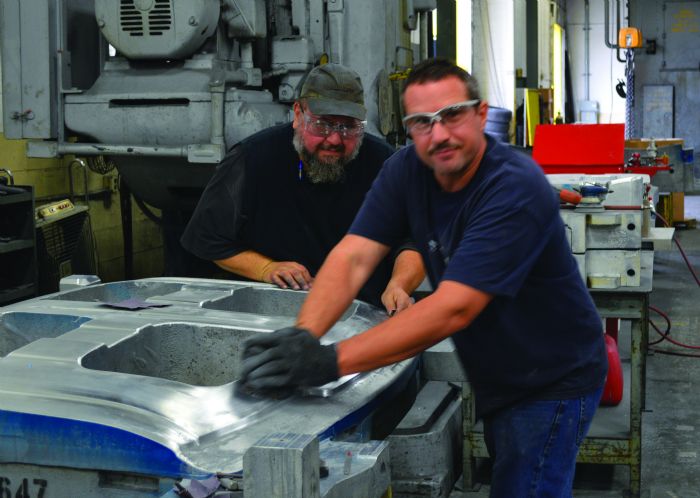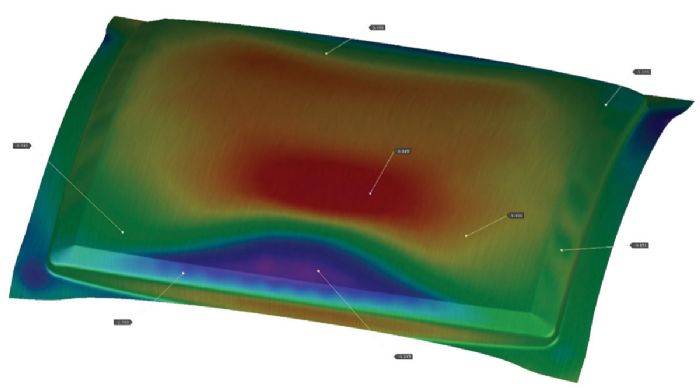 “Our thought process is that we do everything in-house. That helps us control our own destiny,” Mike says. “We can design the tooling and build it to run in our presses, using our knowledge to do so. We only outsource the plating and painting.”
“Our thought process is that we do everything in-house. That helps us control our own destiny,” Mike says. “We can design the tooling and build it to run in our presses, using our knowledge to do so. We only outsource the plating and painting.”
In Further Control of Its Destiny
As an extension of Oakley Industries’ desire to control its own destiny, the company recently upgraded its design-simulation software with the AutoForm Forming Suite. AutoForm supplies software for product manufacturability, tool and material cost calculation, die-face design, and virtual stamping as well as body-in-white assembly-process optimization.
“We had other software before, but we rarely used it,” Andrew Oakley says. “The simulations took a long time, and often, it didn’t really work with our processes. It was at least a generation or two older in terms of its capabilities.”
Mike says that using software that’s a good fit with the company’s customers was a factor in choosing which software to buy. “When we talked with our customers and to others in the industry, this AutoForm Forming Suite made sense because our customers, the OEMs, use it, too,” he explains. “That helps us communicate with them better because we’re talking on the same platform as they are.”
Deflecting Defects
Oakley Industries uses the simulation software to prove out draw, flange and crash-form tooling before advancing the tool designs to the shop floor. This process allows the company to prevent most splits, wrinkles and other unwanted features in its prototype parts by changing the design in CAD before casting the dies.
 “We’ll design a tool and have the software evaluate how the tool works,” Andrew says. ”The simulation software shows us where the tool design might result in springback in the part. It’s way ahead of what we used to have.” The company’s designers then can redesign the tooling to compensate for springback with overbending. It also predicts where splits likely will form.
“We’ll design a tool and have the software evaluate how the tool works,” Andrew says. ”The simulation software shows us where the tool design might result in springback in the part. It’s way ahead of what we used to have.” The company’s designers then can redesign the tooling to compensate for springback with overbending. It also predicts where splits likely will form.
“By using the software, we can minimize the amount of sheet metal needed to form the part, cutting scrap and cost. It’s superior in the blank development,” Andrew adds.
Faster to First Good Part
“The whole idea is that we change the tool design in CAD so there’s less work on the floor,” Andrew says. “Alterations to the tools that we might have made out on the floor through trial and error, we now do in advance in CAD. We’re able to use the CAD drawing from the get-go in the beginning on the first runs. The tool design is more likely to work the first time out.”
That capability also helps to reduce scrap. “Right off the bat, we are reducing the initial scrap and, most importantly, the time it takes to make a good part,” he continues.
“I wouldn’t say that we never make changes to the tool design, but we definitely make far fewer. We need far fewer tryout parts because we’ve done most of the work ahead of time,” Andrew concludes.
Better Quality, Quicker Out
Defect-free parts and 100%-on-time shipments center the company’s philosophy. “That’s in our mission statement,” Mike states. He says that the software has expedited the process by as much as 10%. “The software absolutely has an effect on our on-time delivery because it shortens the time to make parts.”
In terms of cost, Mike believes that the new software saves the company money overall. “We didn’t do a detailed financial analysis before buying the new software,” he says, “but it’s easy to see how the software pays for itself in less work out on the floor.”
Mike acknowledges that using better simulation software isn’t unique. He views it as an additional improvement that helps pave the way for faster throughput, better quality and company growth. “This is something that most of our competitors do as well,” Mike concludes. “It’s not like we’ve sparked a lightning bolt. It’s another way that we can speed up our processes and reduce our costs.” MF
Industry-Related Terms: Blank,
CAD,
Center,
Draw,
Drawing,
Fixture,
Flange,
Form,
Forming,
LASER,
Manufacturability,
NC,
Prototype,
Run,
ScrapView Glossary of Metalforming Terms
See also: AutoForm Engineering USA, Inc.
Technologies: Software
 “My father, Ronald Oakley, started the business with my mom, Brenda, in 1980,” says Mike Oakley. “They worked in the back of a building and a year later moved into another building. Then we expanded by adding onto those buildings and buying more buildings. Now we own five facilities all on the same street—roughly 150,000 sq. ft. in total. Just as we added manufacturing space gradually over time, we expanded our capabilities.”
“My father, Ronald Oakley, started the business with my mom, Brenda, in 1980,” says Mike Oakley. “They worked in the back of a building and a year later moved into another building. Then we expanded by adding onto those buildings and buying more buildings. Now we own five facilities all on the same street—roughly 150,000 sq. ft. in total. Just as we added manufacturing space gradually over time, we expanded our capabilities.” Each of the buildings is a separate business unit. One building houses press operations with 14 stamping presses. A second building focuses on sheet metal fabrication, equipped with seven laser cutting machines and four CMMs; a third is dedicated to welding and assembly; and a fourth to robotic welding, assembly and warehousing. The fifth building is responsible for tooling, with a pattern shop, fixture shop, NC mills and its own kirksite foundry.
Each of the buildings is a separate business unit. One building houses press operations with 14 stamping presses. A second building focuses on sheet metal fabrication, equipped with seven laser cutting machines and four CMMs; a third is dedicated to welding and assembly; and a fourth to robotic welding, assembly and warehousing. The fifth building is responsible for tooling, with a pattern shop, fixture shop, NC mills and its own kirksite foundry. 






 “Our thought process is that we do everything in-house. That helps us control our own destiny,” Mike says. “We can design the tooling and build it to run in our presses, using our knowledge to do so. We only outsource the plating and painting.”
“Our thought process is that we do everything in-house. That helps us control our own destiny,” Mike says. “We can design the tooling and build it to run in our presses, using our knowledge to do so. We only outsource the plating and painting.” “We’ll design a tool and have the software evaluate how the tool works,” Andrew says. ”The simulation software shows us where the tool design might result in springback in the part. It’s way ahead of what we used to have.” The company’s designers then can redesign the tooling to compensate for springback with overbending. It also predicts where splits likely will form.
“We’ll design a tool and have the software evaluate how the tool works,” Andrew says. ”The simulation software shows us where the tool design might result in springback in the part. It’s way ahead of what we used to have.” The company’s designers then can redesign the tooling to compensate for springback with overbending. It also predicts where splits likely will form.
 Webinar
Webinar
